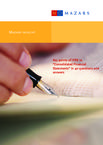Key points of IFRS 10 “Consolidated Financial Statements” in 40 questions and answers
According to the IASB’s schedule, the new standard is effective from 2013 for entities with a reporting date at the end of the calendar year.
It may change the scope of consolidation (i.e. which entities should be consolidated) but the consolidation techniques remain the same (i.e. how to carry out consolidation).In addition to the new definition of control, IFRS 10 includes clarifications on various issues which were not previously addressed by the IFRS framework, including:
- the difference between protective rights and substantive rights; de facto control;
- the difference between an agent and a principal;
- the concept of “silos”.
IFRS leaves a large amount open to professional judgement, particularly as regards potential voting rights (e.g. call options). Given the potential difficulties in applying this standard, it is essential that all stakeholders familiarise themselves with it quickly – particularly preparers of financial statements, auditors and regulators. To help with this, we have prepared the following series of 40 questions and answers.


